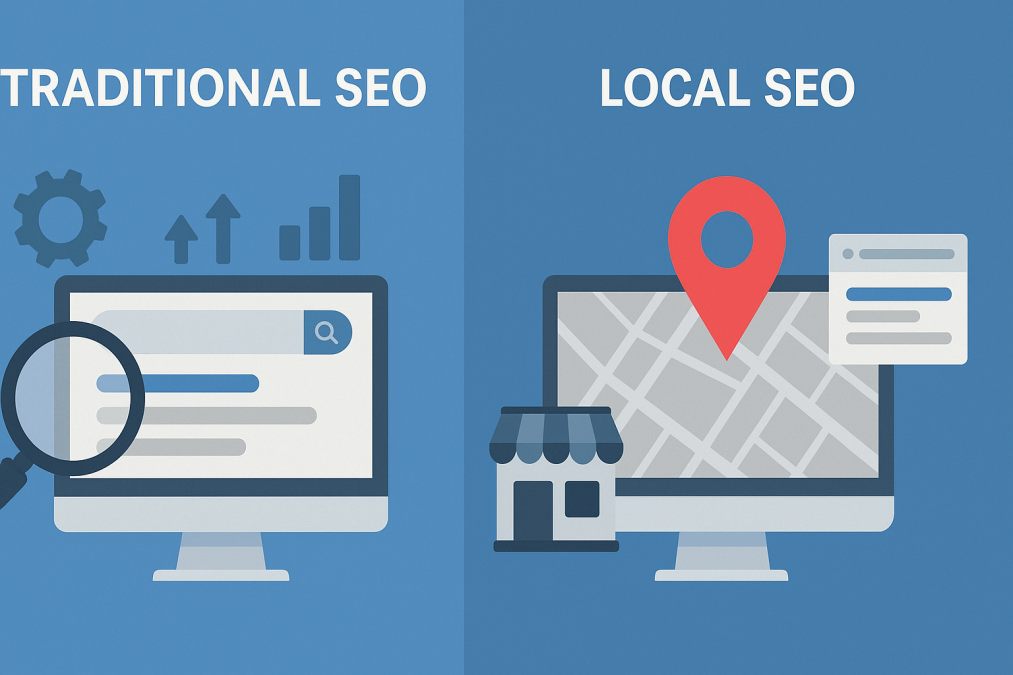In today’s digital-first world, people rely on search engines for just about everything—whether it’s finding the nearest bakery, researching a product, or looking for professional services. If your business isn’t showing up in these search results, you’re losing visibility, traffic, and potential customers.
That’s where Search Engine Optimization (SEO) becomes essential. But SEO isn’t a one-size-fits-all strategy. Businesses today are faced with a crucial question: Should they invest in Local SEO vs Traditional SEO?
To make the right decision, it’s important to understand what each strategy involves, how they differ, and which aligns best with your brand’s goals. This article will break it all down for you.
What is SEO?
SEO, or Search Engine Optimization, is the practice of improving your website to rank higher in search engine results, making it easier for potential customers to find you. The better your ranking, the more traffic, leads, and sales you can expect.
There are two key types:
Local SEO: Optimizes your site and presence for location-based searches (e.g., “dentist near me”).
Traditional SEO: Focuses on broader, non-location-specific keywords (e.g., “best project management software”).
When deciding between Local SEO vs Traditional SEO, it’s important to choose the right approach based on your business model and target audience.
What to Look for in an SEO Strategy
Before choosing between local SEO vs traditional SEO, ask yourself:
-
Are your customers based in a specific area or city?
-
Do you rely on foot traffic, appointments, or local service zones?
-
Or, are you trying to grow a wider audience beyond geographic limits?
-
Does your website sell products nationally or offer information-based content?
Knowing your audience and how they search will help determine which SEO path makes the most sense for your brand.
Local SEO: Build Visibility Within Your Neighborhood
Local SEO helps businesses rank for searches tied to a specific location. Think of searches like “bakery in downtown Chicago” or “plumber near me.” These are hyper-targeted and usually made by people ready to take action.
Why Use Local SEO?
Local SEO is essential for businesses that want to be found by customers in their immediate area. If you’re running a brick-and-mortar store, a local service, or a franchise, your visibility in local search results can directly impact your foot traffic and phone inquiries.
When someone types “near me” or searches for services in a specific city, Google shows them results based on proximity, relevance, and reviews. If your business isn’t showing up there, your competitors likely are.
By using Local SEO, you’re not just appearing in more searches—you’re meeting your potential customers at the exact moment they need you. That’s powerful.
A few key benefits:
-
Reach Ready-to-Buy Customers: People searching locally often want to act fast—call, visit, or book.
-
Improve Visibility on Google Maps: Show up in the local 3-pack and map listings.
-
Boost Trust Through Reviews: More positive reviews means more credibility and clicks.
-
Outperform Local Competitors: Smart optimization helps you stand out in a crowded market.
How to Use Local SEO
Using Local SEO isn’t complicated, but it does require consistency and attention to detail. The goal is to make sure your business information is accurate everywhere and that you’re sending the right signals to Google and your community.
Start with the basics—claim your Google Business Profile, list your services, add photos, and collect customer reviews. Then build from there by optimizing your site and getting listed in local directories.
It’s about creating a strong digital presence that mirrors your physical presence.
Start by doing these:
-
Claim & Complete Your Google Business Profile: Add address, contact info, hours, and service areas.
-
Use Location Keywords: Sprinkle your city or region into your site’s titles, content, and meta tags.
-
Collect and Respond to Reviews: Ask happy customers to leave feedback and engage with them.
-
List on Local Directories: Ensure you’re on platforms like Yelp, Bing Places, and niche directories.
Traditional SEO: Grow Your Reach Beyond the Map
Traditional SEO (or Organic SEO) is about optimizing your website for broader, topic-based searches. It’s ideal for businesses that don’t rely on foot traffic, like online retailers, SaaS platforms, and content creators.
Why Use Traditional SEO?
Traditional SEO is the foundation of online visibility for brands that operate beyond a single town or city. Whether you’re an online store, SaaS provider, educational platform, or media site, traditional SEO helps you get found through relevant keywords no matter where your customer is.
It’s a long-term strategy that pays off with consistent organic traffic, stronger brand authority, and better conversion potential. Unlike paid ads, the benefits of good SEO don’t stop when you stop spending.
By investing in Traditional SEO, you’re building a presence that works around the clock to bring people to your site.
Here’s why it works:
-
Grow Organically Without Ads: Save on marketing spend over time with consistent traffic.
-
Reach a Broader Audience: Target buyers, readers, or clients nationally or globally.
-
Establish Expertise: Climbing SERPs shows you’re a trusted voice in your industry.
-
Drive Long-Term Results: Quality content and optimization generate traffic for years.
How to Use Traditional SEO
Traditional SEO starts with understanding your audience and what they search for. From there, it’s about creating content that answers their questions, optimizing your site, so search engines can understand it, and building authority through backlinks and user experience.
Think of it as building a library of valuable content paired with strong technical foundations. It takes time, but the payoff is exponential.
Here’s what to focus on:
-
Keyword Research: Use tools to find relevant, high-volume keywords your audience is typing into Google.
-
Create SEO-Rich Content: Publish blogs, landing pages, and product info that educate or solve problems.
-
Optimize On-Page Elements: Titles, meta descriptions, headers, and internal linking all matter.
-
Build Authoritative Backlinks: Earn links from trusted sites through guest posts, PR, and partnerships.
Local SEO vs Traditional SEO: Key Differences
| Feature | Local SEO | Traditional SEO |
|---|---|---|
| Audience Focus | Local customers | National or global audience |
| Search Type | “Near me” or location-specific | Topic or keyword-driven |
| Best For | Physical stores, local services | Online stores, blogs, SaaS |
| Tools Used | Google Business Profile, citations | Website content, backlinks |
| Primary Goal | Foot traffic, local inquiries | Leads, traffic, brand visibility |
| Results Timeline | Often quicker | Long-term and scalable |
Which One Should You Choose?
It depends on your business model.
If you’re a dentist, restaurant, or home service provider targeting a city or region—go Local SEO.
If you’re a software brand, blog, or eCommerce store selling across the country—go Traditional SEO.
Many brands actually need both. For example, a local business with an online store could benefit from being found locally and nationally, making Local SEO vs Traditional SEO a crucial consideration for your strategy.
Ready to Grow with SEO?
If you’re serious about increasing visibility, traffic, and conversions, the right SEO strategy—whether Local SEO vs Traditional SEO—can make a big difference. That’s where Wbcom Designs comes in. Our team offers tailored SEO solutions—whether you’re targeting a local audience or building a global brand.
We combine local listings, content strategy, technical optimization, and backlink outreach to help you rank where it matters most. Our goal is to make SEO accessible and effective for every type of business.
Interesting Reads:





